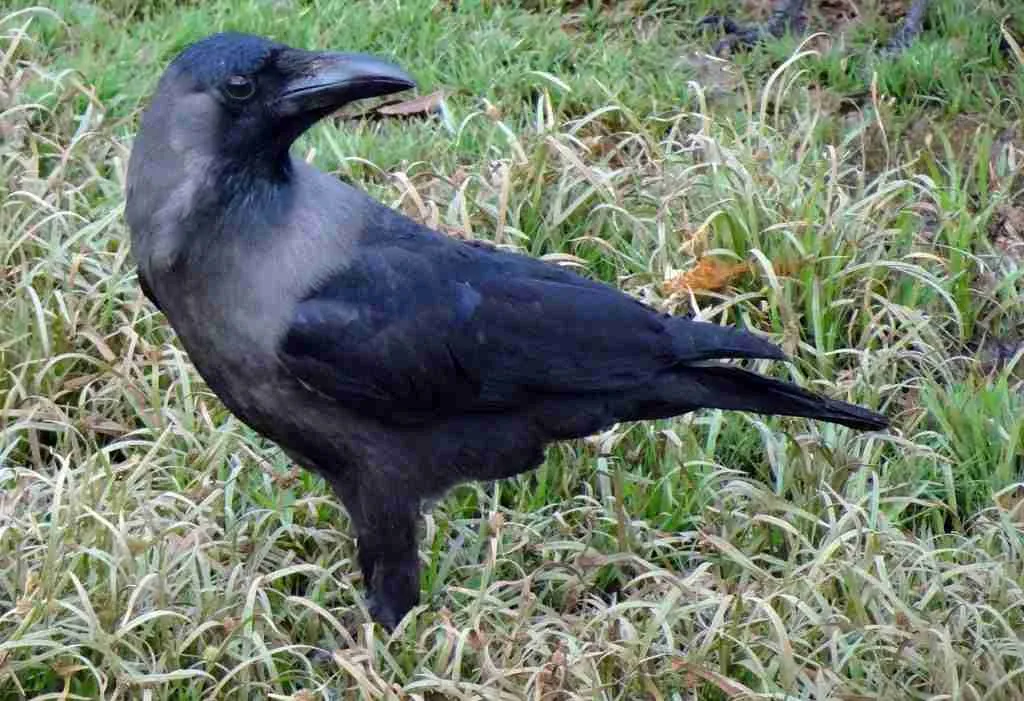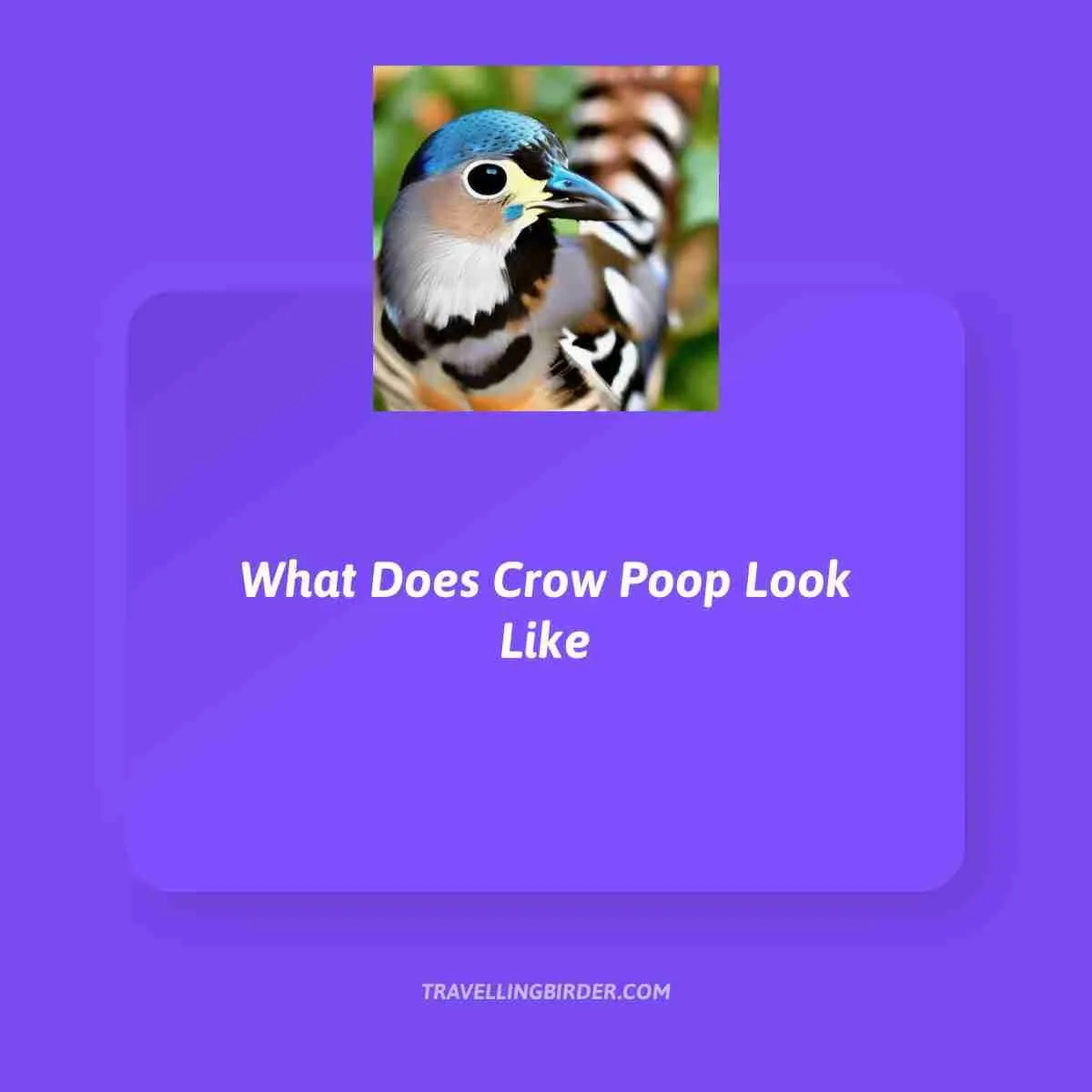Crows are a widely distributed family of birds, with species inhabiting all continents except Antarctica. As such, they can be found in many habitats and environments. One interesting aspect of crows is their feces – what does crow poop look like? In this article we will explore the answer to that question from an ornithologist’s perspective.
The first thing to note about the appearance of crow droppings is its size. Crows have relatively large bodies for songbirds, so it stands to reason that their excrement would also be on the larger side compared to other avian species. In general, crow droppings measure around 1/4 inch long and tend to be cylindrical or cone-shaped in shape. They may also contain small pieces of undigested food depending upon the diet of the individual bird.
Furthermore, there can be some differences between fresh and aged droppings as well as varying colors based on the type of foods eaten by each particular species. Fresh droppings are usually dark brown or black in color while older fecal matter tends to lighten over time due to oxidation processes occurring within them. Additionally, white specks might appear if calcium carbonate has been ingested through certain types of vegetation or insects consumed by these birds.
This concludes our introductory overview into the appearance and composition of crow faeces; stay tuned for more detailed information regarding this fascinating topic!

Characteristics Of Crow Droppings
Crow droppings may not be the most pleasant thing to consider, but they can tell us a lot about these feathered creatures. As an ornithologist, I often find myself studying crow droppings and analyzing their characteristics in order to determine what type of environment crows prefer.
When it comes to appearance, crow droppings are usually black or gray in color with a runny consistency similar to that of paint. They tend to have small white specs scattered throughout which are actually bits of undigested seeds and other materials from their diet. The shape of the dropping also varies depending on where it was deposited; for example, if it is left on a flat surface like pavement, you will likely see a more circular shape whereas if it is left on vegetation such as grass, then you will likely observe something closer to oval-shaped.
Areas Where Crows Congregate
Crows are known to congregate in a variety of habitats and locations. They can be seen gathering in urban areas, such as parks or city streets, but they also inhabit rural environments with trees, crops, and open fields. Crows tend to prefer open spaces that provide them with access to food sources like insects, seeds, fruits, small animals, eggs, and carrion.
In addition to these common places of congregation, crows may form large flocks when conditions are suitable for roosting or breeding. These larger gatherings typically occur during the winter months when food is scarce and the need for shelter is great. During this period crows often gather at night in sheltered woodlands where they nest and feed together until spring arrives.
The presence of large populations of crows has implications for both human-inhabited areas and natural ecosystems alike. While their scavenging behavior provides some benefit by cleaning up dead organic matter from roadsides and other disturbed landscapes, it can also lead to damage on agricultural land as well as decreased water quality due to concentrated droppings near wetland areas. As we consider the effects of crow droppings on the environment, it’s important to remember that understanding how and where these birds congregate will help us better manage their impacts on our shared planet.
Effects Of Crow Droppings On The Environment
Crow droppings can have a significant effect on the environment. Firstly, these droppings are composed of uric acid and are acidic in nature, thus they can corrode metal surfaces. Secondly, when large numbers of crows congregate their droppings may create an area with high levels of bacteria which can be dangerous to humans as well as other animals. Lastly, due to their acidic composition, crow droppings can also damage vegetation or soil nutrition if left unchecked for long periods of time.
Overall, it is important to manage the amount of waste created by crows in order to protect our environment from potential harm. Effective management techniques include such things as implementing artificial nesting sites away from populated areas or creating barriers that stop birds from accessing certain places. In addition, regularly cleaning up after crows will help ensure their droppings don’t present any health risks or environmental hazards. With proper maintenance and protection measures in place, we can keep ourselves and our environments safe from the damaging effects of crow poop.
Cleaning Up After Crows
It is said that a single crow can carry thousands of memories, but it also carries the remnants of its meals. The sight of white and grey splotches on pavement or grass can be an unwelcome reminder of crows’ presence in our lives. Cleaning up after these birds can seem like a daunting task, especially when they have been frequent visitors to our gardens or yards for years.
Crow droppings are small, blackish-brown pellets with white deposits that look similar to mouse or rat feces. They usually contain bits of undigested seeds, fruits, insects, feathers, and other materials eaten by crows. Crow droppings may attract pests such as flies and ants so it is important to get rid of them quickly before these insects become established in your yard. A good first step would be to use a broom and dustpan to sweep away the droppings from hard surfaces such as patios or walkways; however, this will not work on lawns or garden beds where bird poop has already seeped into the soil. For those areas, you should rake up any larger pieces then spray down the area with water to loosen smaller particles before removing them with a shovel or scoop.
While cleaning up after crows might seem like an unpleasant chore at times, it does offer us an opportunity to reflect on their importance in our lives – serving as messengers between us and nature – while taking precautions against potential health risks posed by their waste products. With proper prevention strategies in place we can ensure both ourselves and wildlife remain healthy and safe from harm’s way.
Prevention Strategies
Having just discussed the unpleasantness of cleaning up after crows, it is advisable to prevent them from roosting in the first place. Prevention strategies can be classified into two broad categories: physical and non-physical deterrents.
| Physical Deterrents | Non-Physical Deterrents |
|---|---|
| Loud noises | Scarecrow |
| Reflective tape | Bright lights |
| Netting | Fake predators |
| Sprinklers | Chemical repellents |
Physical deterrents are designed to make use of a crow’s heightened senses. The most widely used form of physical deterrence is noise; by playing loud music or sounds, this will disrupt their regular patterns as they try to avoid being disturbed. Another effective method is reflective devices such as shiny tape or foil which reflects light and creates an uncomfortable atmosphere for the birds. Additionally, netting can be installed around structures that have been known to attract crows as well as sprinklers that provide sudden bursts of water when activated by motion sensors.
Non-physical deterrents use visual cues and illusions to scare away birds without causing any harm. A classic example is the scarecrow, with its tall stature, wide brim hat, colorful clothing, and piercing eyes all meant to frighten off unwanted visitors. Other methods include bright lights set on timers so they turn on at dusk when crows usually inhabit certain areas; fake predator models like owls placed near potential roost sites; and chemical repellents such as those containing methyl anthranilate—a naturally occurring compound found in some fruits that has an unpleasant taste for birds yet poses no threat whatsoever to humans or animals .
With these various techniques available, one should find success in keeping crows away from undesired locations while also helping protect local wildlife populations without resorting to cruel tactics or unnecessary destruction of property.
Frequently Asked Questions
How Long Does It Take For Crow Droppings To Decompose?
When it comes to crow droppings, many people are interested in how long it takes for them to decompose. As an ornithologist, I am often asked this question and there is no single answer since the rate of decomposition depends on several factors such as location, climate, temperature, and moisture levels. Here’s a breakdown of what you need to know about the process:
-Crow droppings can take anywhere from two weeks to one year or longer to fully decompose.
-The hotter and wetter the environment, the faster they will break down.
-Decomposition also occurs more quickly if the area has other organic matter present that helps with breaking down nutrients.
In addition to geographical conditions affecting decay rates, another factor that impacts how long it takes for crow droppings to decompose is their composition itself. Generally speaking, these excrement deposits are composed of indigestible materials like feathers, fur and bones which don’t biodegrade easily. This means even under optimal environmental conditions they can still take some time before becoming part of the soil again.
All things considered then, while we may not be able to pinpoint exactly how long it takes for crow droppings to completely disappear into the earth’s surface, understanding different environmental factors that affect the speed at which they do so can help us get a clearer picture.
What Can Be Done To Deter Crows From Congregating In A Certain Area?
As an ornithologist, I have been asked many times what can be done to deter crows from congregating in a certain area. This is a difficult question and the answer will depend on why they are there in the first place. In some cases, simply making the area less attractive or providing more attractive alternatives may do the trick; however, often it takes a combination of methods for successful crow control.
Coincidentally, one of the simplest ways to discourage crows from visiting your property is to make sure that food sources are not available. Crows scavenge for food almost everywhere, so removing any potential food sources – such as pet food left outdoors or bird feeders – can help discourage them from hanging around your yard. Additionally, other common deterrents include noise-making devices like propane cannons that produce loud noises every few minutes or chemical repellents applied directly onto surfaces where birds land or roost.
While these tools are effective at reducing crow numbers in areas, it should also be noted that preventing congregation altogether is usually impossible since crows form strong social bonds with each other and tend to travel together in family units even when they’re looking for new places to live. As such, if you find yourself dealing with persistent problems caused by crows, setting up permanent exclusion techniques such as netting over crops or open spaces may offer long-term relief.
Are There Any Health Risks Associated With Coming Into Contact With Crow Droppings?
As an ornithologist, I am often asked questions about the health risks associated with coming into contact with crow droppings. The answer is complex and depends on a variety of factors, such as how long the droppings have been exposed to the elements, where they are located, and if anyone has recently come into contact with them.
In general, however, there can be some potential health risks when coming into contact with crow droppings. These include bacteria such as salmonella and E. coli that can cause gastrointestinal issues if ingested or inhaled; parasites like roundworm and tapeworm which may infect humans through direct skin contact; and fungal infections like histoplasmosis which can be caused by breathing in spores from dried droppings. Additionally, all bird droppings contain uric acid, which can cause irritation to the eyes or skin upon contact.
It is important for people to take precautions when handling any kind of bird feces – especially those from crows – to avoid any potential negative effects on their health. Wearing protective gloves, eye protection, and a face mask when working around areas where birds roost or congregate will help reduce exposure to these substances. Regularly cleaning up after crows using proper sanitation practices also helps minimize risk of disease transmission from their waste products.
Are There Any Benefits To Having Crows In An Area?
Indeed, crows are some of the most intelligent and adaptable birds in the world. As such, having crows in an area can be beneficial. Firstly, their presence often indicates a healthy ecosystem. Crows will only settle down where they have enough food to sustain them; so if there’s an abundance of crows in an area it means that it is richly populated with animals or other sources of sustenance. This also has positive secondary effects – for example, more prey species may mean better control over pests like rodents.
Additionally, crows provide a great level of pest control by scavenging on dead animals which could otherwise cause disease outbreaks or odors. They also feed on insects and worms which helps keep populations balanced as well as reducing insect-related diseases and damage to crops. Furthermore, some studies suggest that when large numbers of crows congregate together this can act as a deterrent to predators who would usually hunt smaller birds – providing extra protection for these less able flyers. Finally, simply hearing the distinctive call of these birds can bring joy to many people!
In summary then, having crows in an area brings numerous benefits: from indicating a healthy environment to helping maintain balance within ecosystems through pest control and predator deterrence. Even if you don’t appreciate their presence directly through sight or sound, we can still thank them for all their unseen work!
Are There Any Other Animals That Leave Droppings Similar To Those Of Crows?
When it comes to avian excrement, crows leave droppings that are quite distinct. But what other animals might be leaving a similar deposit in their wake? To answer this question, let’s take a look at the world of ornithology and explore some of the different types of bird droppings one may find.
The first type we’ll examine is from owls. Owls typically create pellets composed of fur, bones, claws, teeth, and feathers – all indigestible items they consume whole or in large pieces. The pellets have an earthy color with splotches of black and white as well as red or yellow depending on the species. While owl pellets appear somewhat similar to crow droppings upon close inspection there are distinct differences; for example, owl pellets tend to have more defined shapes than those left by crows.
Next up is seabird guano which can vary greatly in size and shape but generally has an off-white hue and crumbly texture. These deposits are often made up of fish remains combined with minerals found in ocean water such as calcium carbonate giving them a chalky feel when touched. Seagulls also produce a very distinct dropping consisting mostly of fish scales due to their diet being mainly composed of seafood like sardines and anchovies. On the other hand, crows feed almost exclusively on fruits, seeds, insects and small rodents so their waste reflects these dietary preferences with its darker coloration caused by undigested berries or nuts alongside insect parts like wings or antennae bits.
It’s clear then that while there certainly are similarities between crow poop and that produced by other birds – particularly owls – each species leaves behind its own unique signature based on its individual diet choices resulting in varying sizes, colors, textures, and components within their respective deposits.
Do Crows Have a Greater Cognitive Ability Than Ravens?
When it comes to crows vs ravens intelligence comparison, the cognitive abilities of these corvids are a fascinating subject of study. While both crows and ravens show remarkable problem-solving skills and can use tools, some research suggests that crows may have a slight advantage in terms of cognitive flexibility and innovative thinking. However, further investigation is needed to fully understand the cognitive abilities of these highly intelligent birds.
Conclusion
It is clear that crow droppings can present an unpleasant nuisance, but they are also a reminder of the value of crows in our ecosystems. It may seem hard to believe, but there can be advantages to having crows nearby. They help control pests and parasites and provide some aesthetic beauty with their lively calls and graceful flight patterns.
That being said, it’s important for us humans not to forget about the potential health risks associated with coming into contact with crow poop and other wildlife droppings. We should take precautions when entering areas frequented by crows, like wearing gloves or covering exposed skin when cleaning up these messes.
Overall, understanding what crow poop looks like gives us insight into how we can manage the presence of these amazing birds around our homes and neighborhoods—and even appreciate them! With proper measures taken, we can learn to peacefully coexist with nature’s feathered friends; after all, as any ornithologist worth his salt knows: Nature is something to behold with wonderment…not fear!

An avid ornithologist, zoologist and biologist with an unwavering passion for birds and wild animals.
Dr. Wilson’s journey in ornithology began in childhood and led him to obtain a Ph.D. in Ornithology from the prestigious Avian Research Institute. He has worked closely with renowned experts in the field and conducted extensive research and field studies globally.




